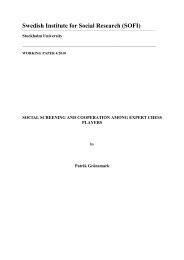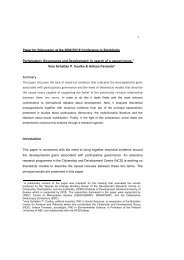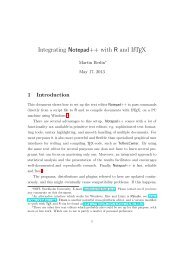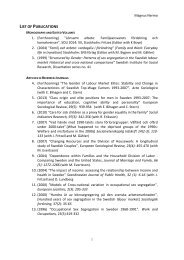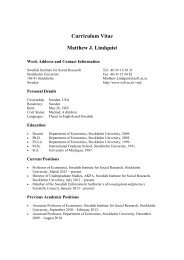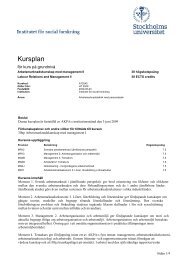Subjective Well-Being, Income and Economic Margins - DiVA
Subjective Well-Being, Income and Economic Margins - DiVA
Subjective Well-Being, Income and Economic Margins - DiVA
Create successful ePaper yourself
Turn your PDF publications into a flip-book with our unique Google optimized e-Paper software.
personal disposable income <strong>and</strong> adjusted disposable household income. The adjusted<br />
measure is the sum of the respondent’s <strong>and</strong> his or her spouse’s monthly disposable<br />
income, divided by the square root of the number of family members in the household,<br />
including children. This measure is thus meant to capture increased living costs due to<br />
children <strong>and</strong> household economies of scale.<br />
Moreover, we use an indicator of economic margins based on the following survey<br />
question: “If a situation suddenly arose where you had to come up with 10,000 kr, could<br />
you manage it (yes ; no)” The figure amounts to ca. 2170 USD in 2011 prices, <strong>and</strong><br />
was adjusted upwards to 12,000 SEK in year 2000, keeping it roughly constant in real<br />
terms. The amount represents about one month’s worth of average disposable income<br />
during the period 1991–2000. 8.6% <strong>and</strong> 8.1% reply ‘no’ to this question in 1991 <strong>and</strong><br />
2000. We can think of this variable as capturing the bottom tail of the (liquid) wealth<br />
distribution. Other possible interpretations will be discussed later. 5<br />
We use a set of control variables intended to capture various life-cycle events that<br />
might correlate with both well-being <strong>and</strong> economic conditions. As a measure of health we<br />
use a symptom index covering a broad range of afflictions. It is increasing in the number<br />
of symptoms <strong>and</strong> gives severe symptoms twice the weight of mild ones. Household type<br />
is captured by a set of indicator variables for marital status (including cohabitation) <strong>and</strong><br />
whether there are any children living in the household. We use the following indicators of<br />
employment status: full-time, part-time, self-employed, unemployed, retired <strong>and</strong> other.<br />
In our cross-sectional analysis we also use indicators of age group, sex <strong>and</strong> education<br />
level. The variables are described in more detail in Appendix I.<br />
3.3 Descriptive statistics<br />
The sample distributions of the two satisfaction measures in 1991 <strong>and</strong> 2000 are shown<br />
in figure 1. Few Swedes appear to be dissatisfied: only 4.6% report LCS to be worse<br />
than ‘rather good’ <strong>and</strong> only 5.6% respond ‘no’ to the DLS question. We also see that<br />
the overall levels of both satisfaction measures are stable between 1991 <strong>and</strong> 2000. Intraindividual<br />
variation in LCS over time is shown in table 1.<br />
The best predictor of an<br />
individual’s satisfaction level in 2000 is his or her satisfaction level in 1991, given that<br />
5 Since our register data also contain information on wealth for all individuals we can to some extent<br />
examine whether our economic margins variable seems reliable. It turns out that there is no overlap at all<br />
between self-reported lack of economic margins <strong>and</strong> the top decile of the wealth distribution according<br />
to the tax register; this increases our confidence in the economic margins measure. Wealth has not<br />
been included in our final specifications since this variable is severly left-censored (the tax authorities<br />
collecting the register data are only concerned with wealth above the deductible level). However, whether<br />
or not it is included has little effect on the results.<br />
7



